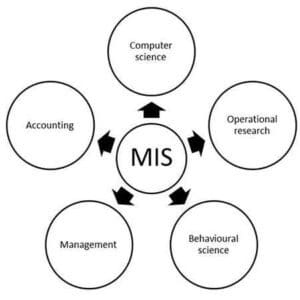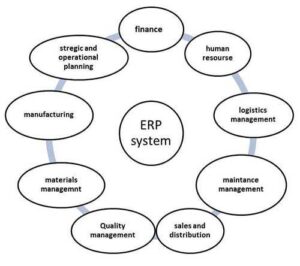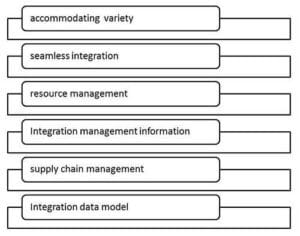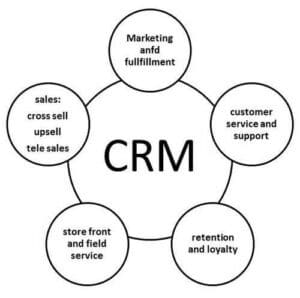Enterprise applications
Enterprise applications are specifically designed for the sole purpose of promoting the needs and objectives of the organizations.
Enterprise applications provide business-oriented tools supporting electronic commerce, enterprise communication and collaboration, and web-enabled business processes both within a networked enterprise and with its customers and business partners.
Services Provided by Enterprise Applications
Some of the services provided by an enterprise application includes:
- Online shopping, billing and payment processing
- Interactive product catalogue
- Content management
- Customer relationship management
- Manufacturing and other business processes integration
- IT services management
- Enterprise resource management
- Human resource management
- Business intelligence management
- Business collaboration and security
- Form automation
Basically these applications intend to model the business processes, i.e., how the entire organization works. These tools work by displaying, manipulating and storing large amounts of data and automating the business processes with these data.
Most Commonly Used Enterprise Applications
Multitude of applications comes under the definition of Enterprise Applications. In this section, let us briefly cover the following applications:
- Management information system(MIS)
- Enterprise Resource Planning(ERP)
- Customer Relationship Management (CRM)
- Decision Support System(DSS)
- Knowledge Management Systems (KMS)
- Content Management System (CMS)
- Executive Support System (ESS)
- Business Intelligence System (BIS)
- Enterprise Application Integration (EAI)
- Business Continuity Planning (BCP)
- Supply Chain Management (SCM)
Management Information System
To the managers, Management Information System is an implementation of the organizational systems and procedures. To a programmer it is nothing but file structures and file processing. However, it involves much more complexity.
The three components of MIS provide a more complete and focused definition, where System suggests integration and holistic view, Information stands for processed data, and Management is the ultimate user, the decision makers.
Management information system can thus be analyzed as follows:
Management
Management covers the planning, control, and administration of the operations of a concern. The top management handles planning; the middle management concentrates on controlling; and the lower management is concerned with actual administration.
Information
Information, in MIS, means the processed data that helps the management in planning, controlling and operations. Data means all the facts arising out of the operations of the concern. Data is processed i.e. recorded, summarized, compared and finally presented to the management in the form of MIS report.
System
Data is processed into information with the help of a system. A system is made up of inputs, processing, output and feedback or control.
Thus MIS means a system for processing data in order to give proper information to the management for performing its functions.
Definition
Management Information System or ‘MIS’ is a planned system of collecting, storing, and disseminating data in the form of information needed to carry out the functions of management.
Objectives of MIS
The goals of an MIS are to implement the organizational structure and dynamics of the enterprise for the purpose of managing the organization in a better way and capturing the potential of the information system for competitive advantage.
Following are the basic objectives of an MIS:
- Capturing Data: Capturing contextual data, or operational information that will contribute in decision making from various internal and external sources of organization.
- Processing Data: The captured data is processed into information needed for planning, organizing, coordinating, directing and controlling functionalities at strategic, tactical and operational level. Processing data means: o making calculations with the data o sorting data o classifying data and o summarizing data
- Information Storage: Information or processed data need to be stored for future use.
- Information Retrieval: The system should be able to retrieve this information from the storage as and when required by various users.
- Information Propagation: Information or the finished product of the MIS should be circulated to its users periodically using the organizational network.
Characteristics of MIS
Following are the characteristics of an MIS: It should be based on a long-term planning.
- It should provide a holistic view of the dynamics and the structure of the organization.
- It should work as a complete and comprehensive system covering all interconnecting sub-systems within the organization.
- It should be planned in a top-down way, as the decision makers or the management should actively take part and provide clear direction at the development stage of the MIS.
- It should be based on need of strategic, operational and tactical information of managers of an organization.
- It should also take care of exceptional situations by reporting such situations.
- It should be able to make forecasts and estimates, and generate advanced information, thus providing a competitive advantage. Decision makers can take actions on the basis of such predictions.
- It should create linkage between all sub-systems within the organization, so that the decision makers can take the right decision based on an integrated view.
- It should allow easy flow of information through various sub-systems, thus avoiding redundancy and duplicity of data. It should simplify the operations with as much practicability as possible.
- Although the MIS is an integrated, complete system, it should be made in such a flexible way that it could be easily split into smaller sub-systems as and when required.
- A central database is the backbone of a well-built MIS.
Characteristics of Computerized MIS
Following are the characteristics of a well-designed computerized MIS:
- It should be able to process data accurately and with high speed, using various techniques like operations research, simulation, heuristics, etc.
- It should be able to collect, organize, manipulate, and update large amount of raw data of both related and unrelated nature, coming from various internal and external sources at different periods of time.
- It should provide real time information on ongoing events without any delay.
- It should support various output formats and follow latest rules and regulations in practice.
- It should provide organized and relevant information for all levels of management:
strategic, operational, and tactical.
- It should aim at extreme flexibility in data storage and retrieval.
Nature and Scope of MIS
The following diagram shows the nature and scope of MIS:

Enterprise Resource Planning (ERP)
ERP is an integrated, real-time, cross-functional enterprise application, an enterprise-wide transaction framework that supports all the internal business processes of a company.
It supports all core business processes such as sales order processing, inventory management and control, production and distribution planning, and finance.

Why of ERP?
ERP is very helpful in the following areas:
- Business integration and automated data update
- Linkage between all core business processes and easy flow of integration
- Flexibility in business operations and more agility to the company
- Better analysis and planning capabilities
- Critical decision-making
- Competitive advantage
- Use of latest technologies
Features of ERP
The following diagram illustrates the features of ERP:

Scope of ERP
- Finance: Financial accounting, Managerial accounting, treasury management, asset management, budget control, costing, and enterprise control.
- Logistics: Production planning, material management, plant maintenance, project management, events management, etc.
- Human resource: Personnel management, training and development, etc.
- Supply Chain: Inventory control, purchase and order control, supplier scheduling, planning, etc.
- Work flow: Integrate the entire organization with the flexible assignment of tasks and responsibility to locations, position, jobs, etc.
Advantages of ERP
- Reduction of lead time
- Reduction of cycle time
- Better customer satisfaction
- Increased flexibility, quality, and efficiency
- Improved information accuracy and decision making capability
- Onetime shipment
- Improved resource utilization
- Improve supplier performance
- Reduced quality costs
- Quick decision-making
- Forecasting and optimization
- Better transparency
Disadvantage of ERP
- Expense and time in implementation
- Difficulty in integration with other system
- Risk of implementation failure
- Difficulty in implementation change
- Risk in using one vendor
Customer Relationship Management (CRM)
CRM is an enterprise application module that manages a company’s interactions with current and future customers by organizing and coordinating, sales and marketing, and providing better customer services along with technical support.
Atul Parvatiyar and Jagdish N. Sheth provide an excellent definition for customer relationship management in their work titled – ‘Customer Relationship Management: Emerging Practice, Process, and Discipline‘:
Customer Relationship Management is a comprehensive strategy and process of acquiring, retaining, and partnering with selective customers to create superior value for the company and the customer. It involves the integration of marketing, sales, customer service, and the supply-chain functions of the organization to achieve greater efficiencies and effectiveness in delivering customer value.
Why CRM?
- To keep track of all present and future customers.
- To identify and target the best customers.
- To let the customers know about the existing as well as the new products and services.
- To provide real-time and personalized services based on the needs and habits of the existing customers.
- To provide superior service and consistent customer experience.
- To implement a feedback system.
Scope of CRM

Advantages of CRM
- Provides better customer service and increases customer revenues.
- Discovers new customers.
- Cross-sells and up-sells products more effectively.
- Helps sales staff to close deals faster.
- Makes call centers more efficient.
- Simplifies marketing and sales processes.
Disadvantages of CRM
- Sometimes record loss is a major problem.
- Overhead costs.
- Giving training to employees is an issue in small organizations.

0 Comments